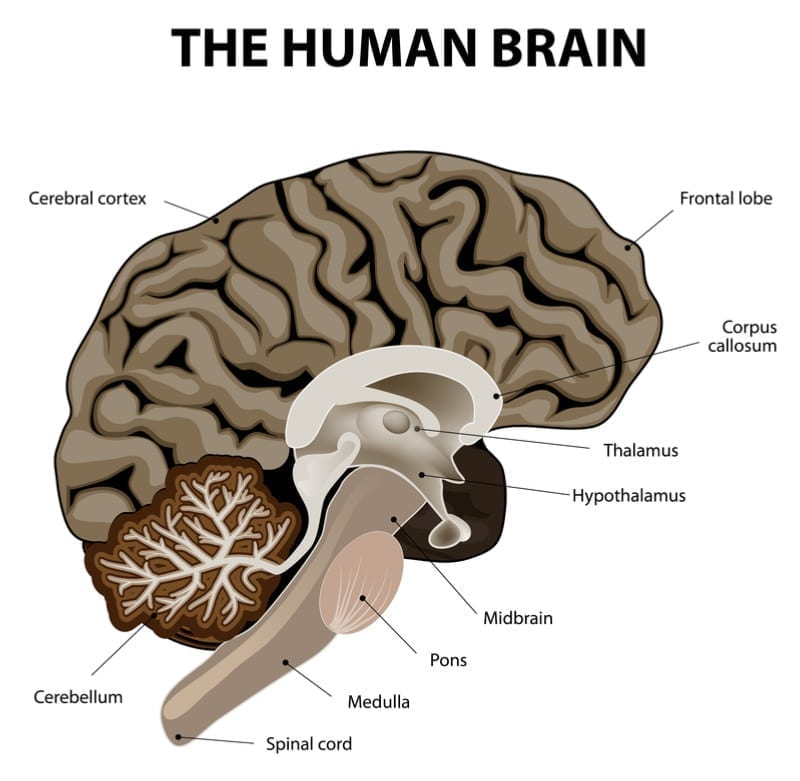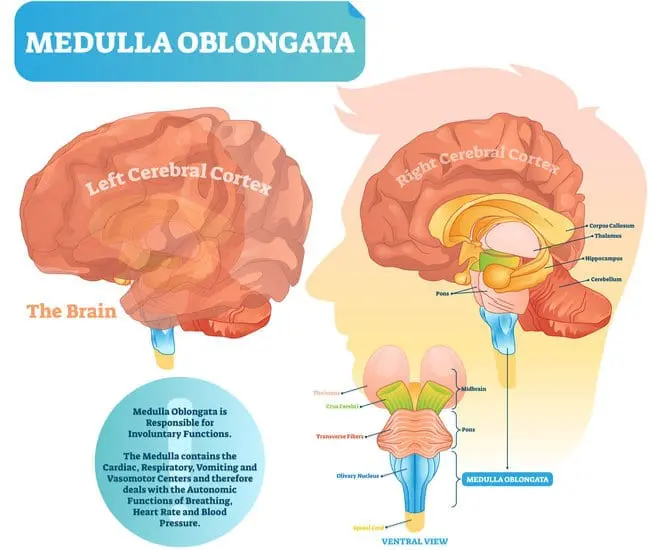Sitting at the lowest part of the brain stem, — one of the four main regions of the brain —, is a cone-shaped structure called the medulla oblongata.
It connects your brain to the spinal cord and controls the function of your autonomous nervous system, and directs brain signals to their correct location.
Why Is the Medulla Oblongata Important?
Although it is just 1.2 inches long, the medulla is without a doubt one of the most important parts of the brain.
How important is it you ask? The medulla handles a wide array of vital tasks that have to do with sustaining life, such as regulating blood pressure and breathing. So living without it would be impossible.
Most of its tasks revolve around managing involuntary or unconscious bodily functions (aka autonomic functions). It also helps transfer neural messages from the brain to the spinal cord.
In this article, we will highlight some of the main functions of the medulla oblongata, talk about the role it plays in the brain, and explain what would happen if your medulla was injured.

The Medulla Oblongata: A Definition
Before we get into details, let’s first define medulla oblongata based on the Merriam-Webster dictionary.
medulla ob·lon·ga·ta |
noun:
- The part of the vertebrate brain that is continuous posteriorly with the spinal cord and that contains the centers controlling involuntary vital functions
Medical dictionaries define medulla oblongata as a wide, stalk-like part of the vertebrate brain that connects to the spinal cord. It contains the nerve centers that are in control of involuntary vital functions.
First discovered in the early 19th century by César Julien Jean Legallois, a French doctor and physiologist who was one of the early practitioners of experimental psychology.
While examining a rabbit brain, Legallois removed the cerebrum and the cerebellum, only to discover that the rabbits could still breathe. However, the breathing ceased as soon as he removed the cone-shaped part at the bottom of the brain.
At Is the Main Function of the Medulla Oblongata?
This is a hard question to answer in one short paragraph, due to the fact that your medulla controls many of your body’s autonomic functions. It also has a stake in your body’s overall major motor movement.
What does the medulla do?
The medulla sits at the very bottom of the brain stem, connecting your brain to the spinal cord, as well as the rest of your body. This means that all impulses that are traveling either to or from the brain must first travel through the medulla before they reach their destination.
The medulla is also in charge of relaying the information obtained from your senses to the cerebrum, where it is processed and organized. It also serves as a bridge between the central nervous system and the peripheral nervous system.
To get a better understanding, let’s break down the roles it plays.
Your body’s autonomic functions are basically bodily responses that happen whether you think about them or not. Everything from breathing patterns, heart rhythms, dilation of your pupils, and even the need to go to the bathroom.
It acts as a manager in delivering all these autonomic functions at the right time of need, speed, and patterns.
Think of this analogy; imagine running a massive multi-million dollar company without a Chief Operation Officer. Good luck keeping things running in order!
The medulla and your cardiovascular system
This part of the brain stem is home to your body’s cardiovascular center. Your cardiovascular center is in control of your blood pressure, heart rate, blood acidity, and all other functions related to your heart.
When the sensors in the medulla detect any change out of the ordinary in the functions mentioned, it will instruct your heart to beat faster or slower to restore optimal function.
The medulla and your nervous system
The medulla also houses many nerves that are in charge of head and shoulder movement, digestion, and speech. It plays a part in body movement coordination and mood control.
What’s more, the medulla oblongata is also responsible for certain reflex actions like sneezing, coughing, and swallowing.

What Will Happen if the Medulla Oblongata Is Damaged?
Whenever they’re performing brain surgery, doctors are extremely careful not to damage or otherwise injure the medulla oblongata. While injuries to most other parts of the brain – including the cerebellum and the cerebrum – can often be reversed, that’s rarely the case with the medulla.
So by now, you’re probably thinking, “ok, good to know. But what if you did actually injure your medulla, what happens then?”
The short answer is, It can be very bad or even fatal.
Why is an injury to the medulla oblongata fatal?
Damage to the medulla can leave a series of long-term effects on the brain, as well as your whole body.
These effects can be mild effects ranging from — difficulty swallowing, numbness, or acid reflux. Or can result in more severe effects such as — partial or total paralysis or impaired movement control.
As we have already explained, the medulla oblongata is in charge of the vital functions of the autonomic nervous system. These include breathing, blood circulation, and heart rate.
If certain regions responsible for those functions were damaged, it would likely cut the supply of blood or air to your brain, your heart, and other parts of your body, resulting in immediate death.

Medulla oblongata: stroke, treatment, and recovery
Stroke of the medulla oblongata: can cause an interruption to vital nerve messages and can result in paralysis to either one or both sides of the body, vision, and coordination problems.
Strokes in that part of the brain also with your body’s normal autonomic functions such as breathing and heart rates rhythms. In some cases, patients that suffer a stroke of the medulla may require a respiratory machine for breathing.
Severe stroke cases to the medulla can cause a symptom known as “locked-in syndrome“. It’s a condition in which the patient remains conscious but is unable to move any part of their body except their eyes, thus keeping them ‘locked in‘ place.
Recovery of a medullary stroke: highly depends on the severity of the stroke and how fast the treatment takes place. Of course, the earlier the better.
Medullary strokes don’t affect language or thinking areas of the brain. Therefore, patients can be more aware and able to focus their minds and consciously participate more fully in the rehabilitation process.
A Word from Mindvalley
We need to understand how our minds work so we can work our minds better.
— Jim Kwik, Author of Mindvalley’s Superbrain Quest
The human brain is one of the most fascinating structures in the universe. It has an endless capacity to grow, develop, and adapt – both physically and mentally. However, we all still have a lot to learn about our brains to be able to use them to their maximum potential.








